Video: Mullet vs 29er With the Same Geometry - Which is Faster?
When the UCI scrapped the rule banning mixed wheel sizes for racing, a lot of teams rushed to experiment with mixed wheel size bikes, which have now become known as mullets. In the early days, a mullet usually meant either squeezing a 29" front wheel and fork into a 27.5" bike, or a 29er bike with a 27.5" rear wheel.
A couple of years ago, Mike Kazimer tested out a 29er bike with 27.5” and 29” rear wheels. The results were … inconclusive - neither setup was outright faster.
But with these setups, you're compromising the geometry to accommodate the mixed wheel sizes. If you fit a smaller rear wheel to a 29er, the bottom bracket might be a little bit too low; if you fit a 29er front wheel to a 27.5” bike, the BB is probably going to be too high. And either way, the head and seat angles might be slacker than what you want, or at least slacker than the bike was designed for.
Now, though, when people talk about a mullet bike, they usually mean a bike that's purpose built for mixed wheel sizes, and these are everywhere now. They allow you to have the mixed wheel sizes without any compromise in geometry.
There's an increasing number of bikes which are designed to fit either wheel sizes in the rear, such as this Geometron G1. By using interchangeable flip-chips, it can accommodate either wheel size in the back without changing the BB height or frame angles. Because the flip chips are between the link and the rear axle, instead of between the link and the shock, the leverage ratio and the suspension kinematics are pretty similar with both wheel sizes too.
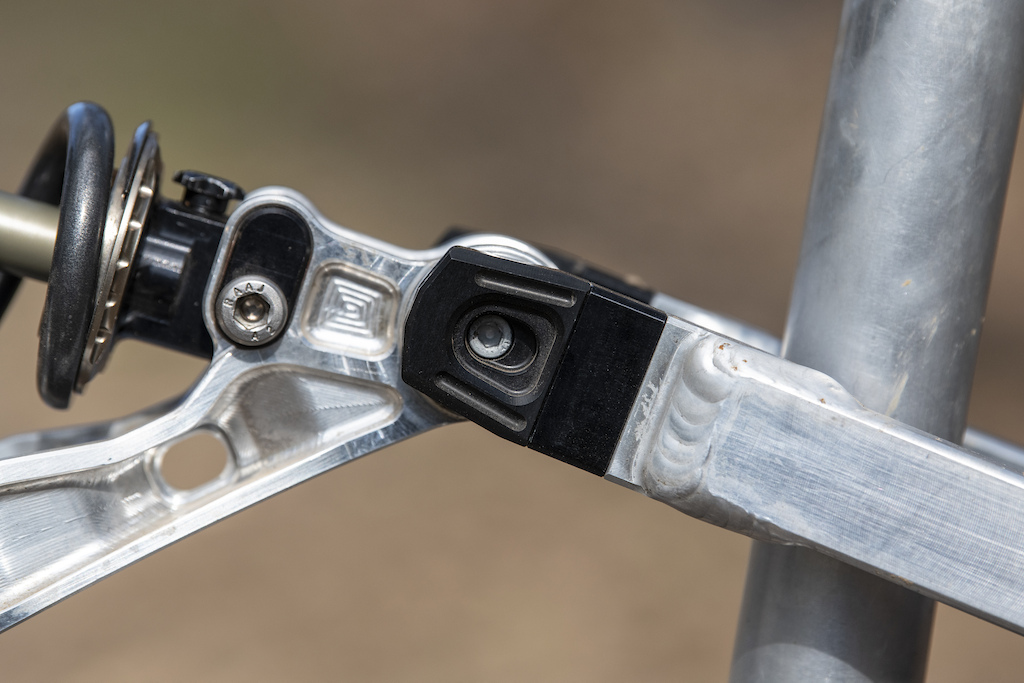
By swapping out the black chips (Geometron calls these Seatstay Mutators) behind the rocker, the G1's geometry can be maintained with either wheel size. Pictured are the longer chips for a 27.5" wheel.
I've tested this bike against the clock with both the 29er and the mullet set up on a couple of different tracks. The first track has a series of fast corners with not much gradient, which is a little awkward to carry speed through, then it drops into a fast section with a load of big roots at the bottom before it drops onto a fire road.
I know this track well, but I did a handful of scoping runs to get fully up to speed before getting the stopwatch out. Then I did two runs on the 29er, then four runs on the mullet, then swapped back and did two more runs on 29". This was to further minimize the effect of getting faster as I became more familiar with the track.
Results
My average time was very slightly faster on the 29er, at 49.5s vs 49.9s on the mullet setup. That's just under half a second or 1% difference. It's not statistically significant, so we can't say the 29er was "the winner" here because there just isn't enough data to go on.
Track 1 lap times
Lap 1 49.9 (29")
Lap 2 49.5 (29")
Lap 3 50.5 (27.5")
Lap 4 50.1 (27.5")
Lap 5 49.9 (27.5")
Lap 6 49.1 (27.5")
Lap 7 49.3 (29")
Lap 8 49.1 (29")
Average: 49.45 (29"), 49.9 (27.5")
Lap 1 49.9 (29")
Lap 2 49.5 (29")
Lap 3 50.5 (27.5")
Lap 4 50.1 (27.5")
Lap 5 49.9 (27.5")
Lap 6 49.1 (27.5")
Lap 7 49.3 (29")
Lap 8 49.1 (29")
Average: 49.45 (29"), 49.9 (27.5")
Subjectively, what surprised me most is how similar the bikes felt in the turns.
When swapping from the 29 to the 27.5” rear wheel, I did feel that the bike tipped into the corner a little bit more willingly. I'm not going to say quicker, but it seems to take less effort to lean into the turn. I don't think this is necessarily “better”; it's just different. And I only noticed this on the first couple of turns so I think that if there is a difference, you get used to it pretty quickly. The 29er is a bit like having a car with slightly heavier steering. It doesn't mean you can’t go round corners just as quickly, it just takes a bit more effort to initiate the turn. But really, the main takeaway is that the difference is very, very subtle. In fact, if it was a blind test I’m not 100% sure if I could tell the difference. But either way, it didn't feel like the mullet was faster through the turns, and that's certainly what the stopwatch suggested.
However, I did notice a difference at the bottom of the track where there's a section of big chunky roots followed by a flat straight. Here, the 29er didn't hang up quite as much and felt a little smoother through the rough. This might have allowed the 29er to edge ahead on the following straight.
Unless you're on the brakes, about 60% of your weight is on the rear wheel, and the rear is more likely to fall into the worst holes and bumps than the front wheel too (this is why we run higher tire pressures at the back). So, the size of the rear wheel probably makes more difference to carrying speed than the front, although the size of the front wheel makes more difference to bike's tendency to "trip up" on large bumps.
For my second test track, I looked for somewhere the benefits of the mullet were most likely to shine. I picked a short section with a steeper gradient to it, which is essentially a series of tight, alternating corners. This is where I thought a mullet was most likely to come into its own. And because the track is so short, I could do lots of runs in quick succession and get very familiar with the track, which is important for noticing differences in handling. But to be honest, both setups felt pretty much indistinguishable. I don't think in a blind test I would have been able to tell the difference and the times back this up.
Track 2 lap times
Lap 1 19.38 (29")
Lap 2 18.70 (29")
Lap 3 19.40 (29")
Lap 4 19.15 (27.5")
Lap 5 18.28 (27.5")
Lap 6 19.29 (27.5")
Lap 7 18.61 (27.5")
Lap 8 (crashed) (27.5")
Lap 9 18.36 (27.5")
Lap 10 18.39 (29")
Lap 11 18.46 (29")
Lap12 18.31 (29")
Average: 18.77 (29"), 18.74 (27.5")
Lap 1 19.38 (29")
Lap 2 18.70 (29")
Lap 3 19.40 (29")
Lap 4 19.15 (27.5")
Lap 5 18.28 (27.5")
Lap 6 19.29 (27.5")
Lap 7 18.61 (27.5")
Lap 8 (crashed) (27.5")
Lap 9 18.36 (27.5")
Lap 10 18.39 (29")
Lap 11 18.46 (29")
Lap12 18.31 (29")
Average: 18.77 (29"), 18.74 (27.5")
I attempted six runs on each wheel size, though on one run with the mullet setup I had a small crash so I discounted that time. The average time was almost identical with both wheel sizes. The difference in the average was much smaller than the range of times posted on either wheel setup, so there’s essentially no difference.
Conclusion
To sum up, in this test I found no real benefit to the mullet setup over the 29er, whether subjectively or against the clock. The main difference I can feel is that the 29er is slightly smoother through very rough terrain. It's not a huge difference, but it's the biggest one I noticed when descending.
But that's not to say that they don’t have a place. I'm 190 centimetres tall (six foot three) so I never really buzz my ass on the rear tire, but for some people this is a problem. Very short riders may still benefit from a full 27.5" setup so that they can get the bar height low enough. But if you're in that in-between size where you can get the bar height in the right place with a 29er front end, but you want the extra clearance on the rear, then a mullet makes a lot of sense.
A brand manager told me that in their internal testing riders over six foot tall (183cm) didn't feel much benefit with a mullet, but many riders under that height did. So perhaps there are benefits for smaller riders, but if you're tall like me you may as well enjoy the roll-over benefits of a 29er.
From manufacturer's perspective, smaller wheels are easier for designers to package into the back of a bike while preserving tire clearance, seat tube shape, chain-line, stiffness and other considerations. Plus, a mullet configuration can work well with a broad range of riders, even if those at the extremes of the height spectrum might be better off with a full 29er or 27.5" bike. Smaller wheels are tougher too, which compensates for the additional punishment a rear wheel receives. After all, this was a major reason behind the OG mullets with 24"/26" wheels like the Specialized Big Hit.
When it comes to the claims of better cornering agility compared to a 29er, I think there was a very subtle difference on the faster turns on the first track, but otherwise both bikes felt almost identical to me, and whatever differences exist are easy to adapt to and not necessarily bad. I know that some people swear there is a benefit here, but with the riding style that I have I can't feel it, nor can I tell a difference with a stopwatch. And that’s despite going out of my way to find terrain likely to benefit the smaller back wheel.
It’s worth saying that I've done similar tests on both of these tracks before, comparing different fork offsets, tire sizes, suspension settings etc..., and I noticed bigger differences with many of these tests. I would say the difference between available fork offsets is quite subtle, but even that made more of a difference to handling than the size of the rear wheel.
What about climbing? Well, there I really did notice a big difference. In theory, the 29er rear wheel helps when getting up and over bumps on technical climbs, but the main difference I noticed is that the smaller back wheel makes the gearing easier. That’s by far the most tangible difference I felt throughout this test.
Author Info:
Must Read This Week
Sign Up for the Pinkbike Newsletter - All the Biggest, Most Interesting Stories in your Inbox
PB Newsletter Signup
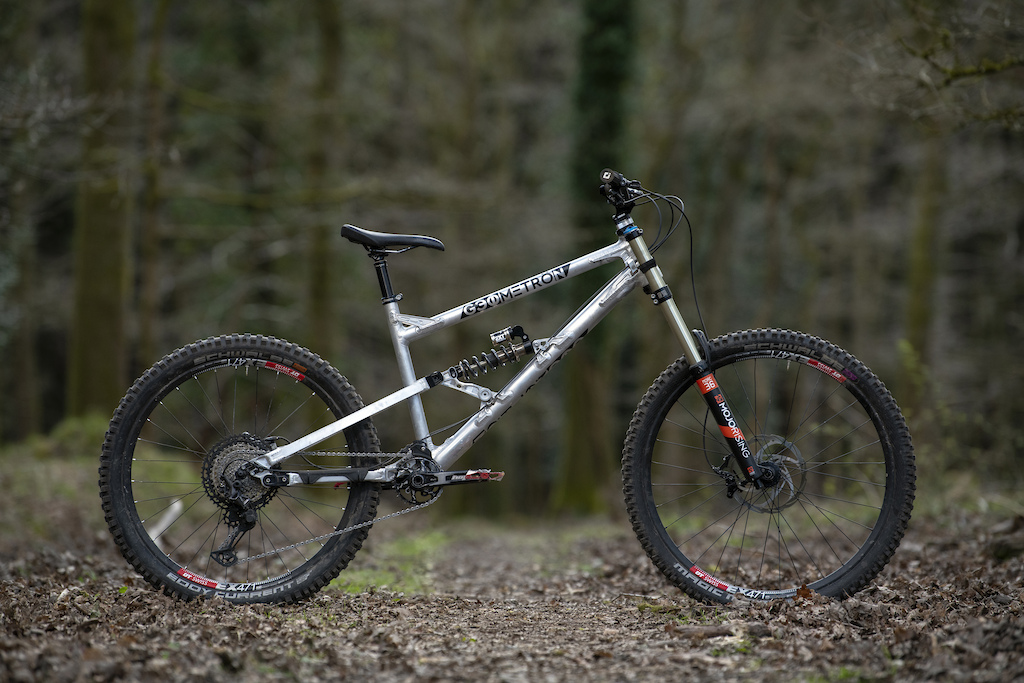
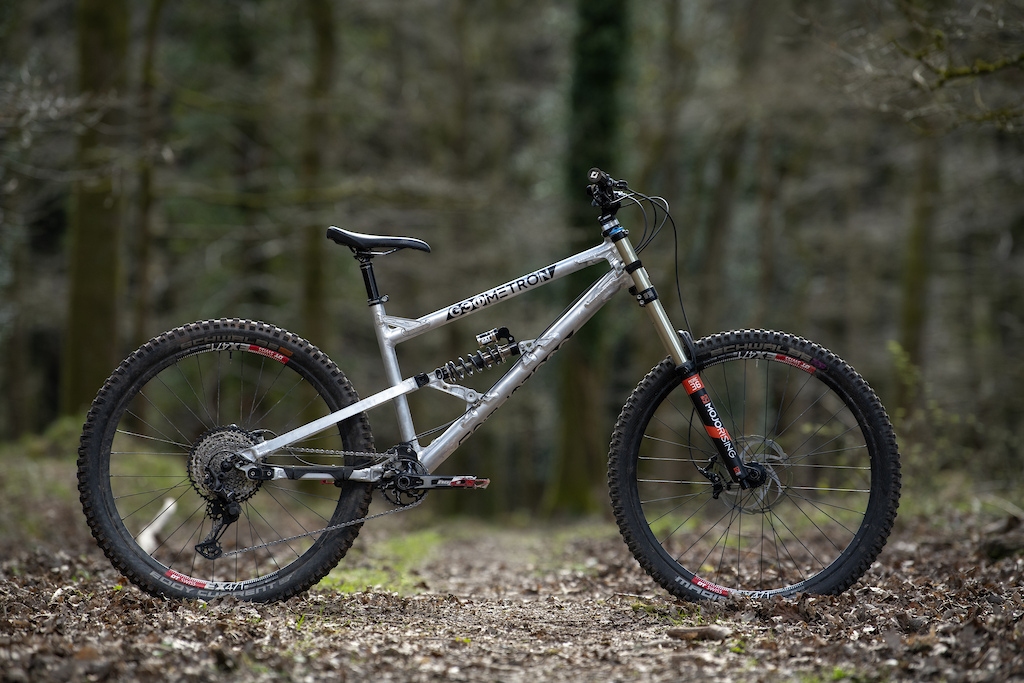
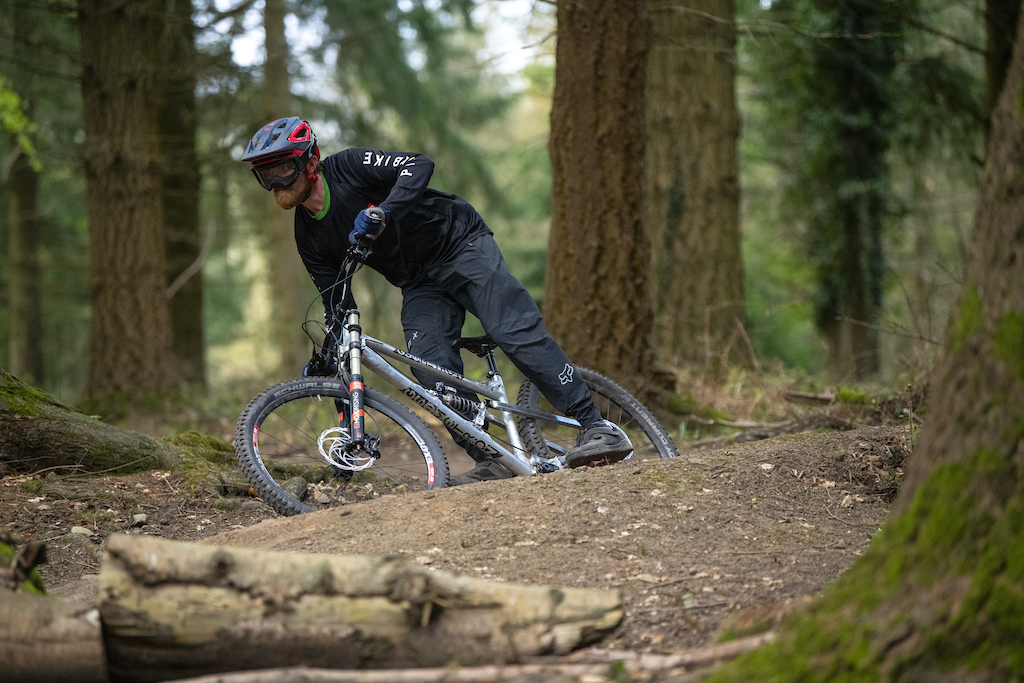
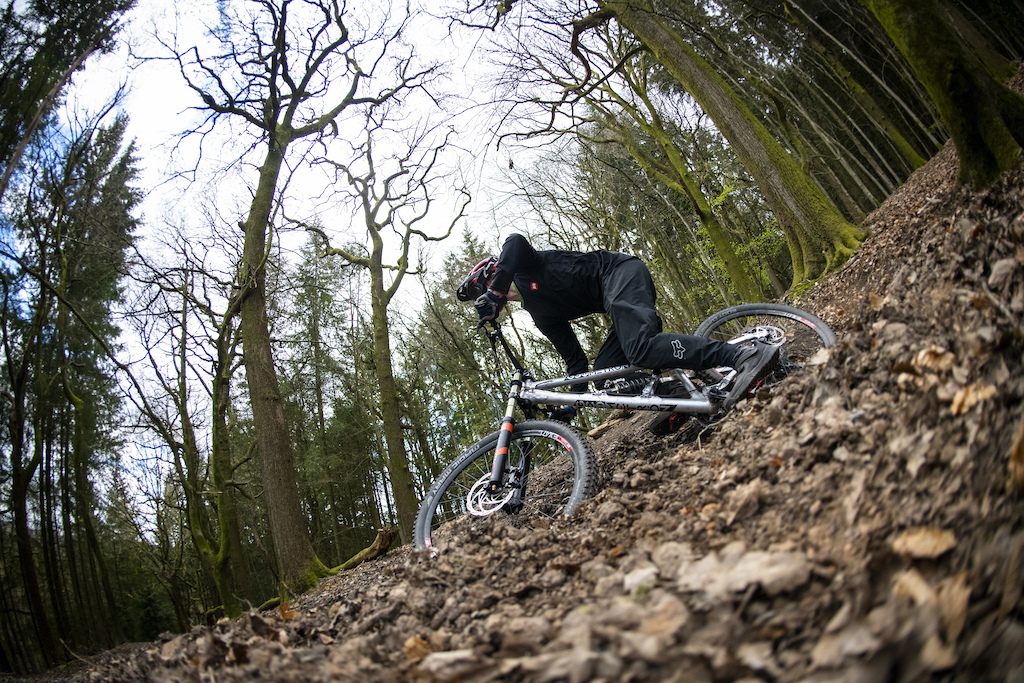
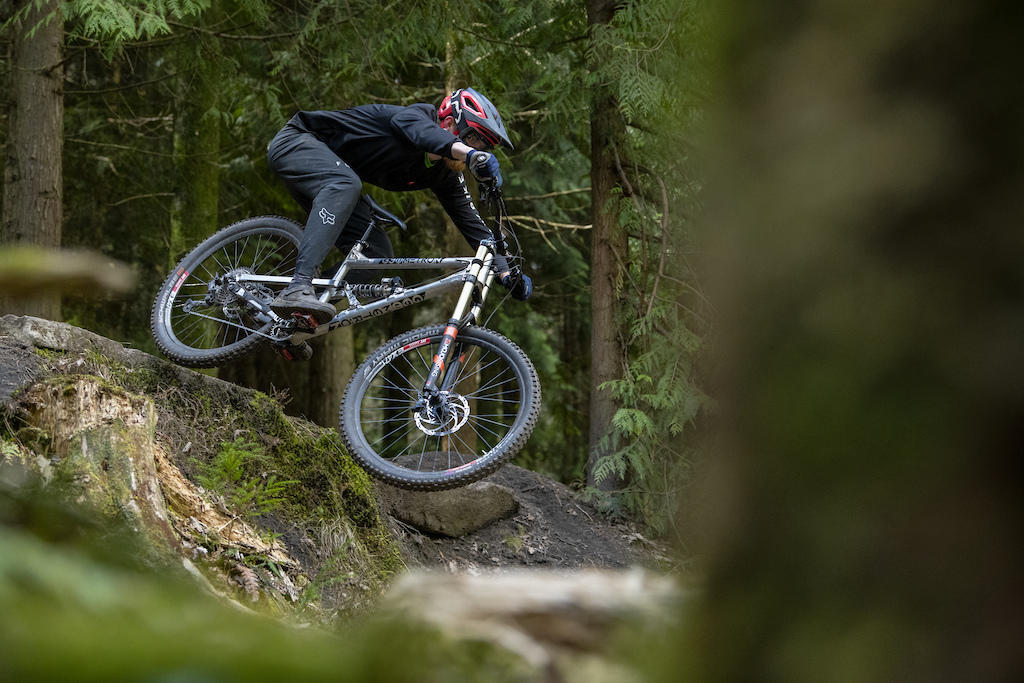

; )
Vs 29, slightly slower in a strait line, rocks and chatter. As fun as a 27.5, less chance of tire buzz.
Vs 27.5 not quite as snappy, less likely to shit your pants when hauling into rocks, slabs and harsh transitions.
Vs both sizes, much harder to wash the front wheel in a turn and much easier to drift.
Ask Minnaar or Pierron who both keep a full 29er because they are tall Versus Brosnan of Danny Hart who prefer a mullet to save their asses...
1. Did flatulence help more on any of the runs increasing propulsion
2. Was there more salt on your neighbors pizza last week
3. Porcupine hardware sonic equinox
I'm afraid there are just too many variables.
The FoD is pretty damn flat. It’s like 100 vertical metres. It’s good fun. But it’s a long way from a WC track, where mullets are currently fast(er?).
Back to back timed runs on some Alpine courses please Seb, I’m sure Brian has the budget with all these mullets out next year!
If mullet bikes are winning world cups , your silly test is useless.
So hard to get these AI quiz questions right.
The test for the Pro teams has nothing to do with the performance of Seb and his setup, riding style, what tracks he rides.
Riders on complete bikes win world cups, not a specific wheel size combination. But their WC runs has nothing to do with Seb's test. The rider is different
You might be surprised what WC teams don't test once you are away from some of the top riders!
Most of my local trails are not good to any hardtail,even XC people rides full suspension bikes and walk away sketchy parts hahaha.
Around Madrid, trails are so gnarly and dirty you need a tank/bike to ride at good pace. Then you go to any bike park and it looks like a highway to me.
The problem with WC results is there's no control - we don't know if Bruni or Reece or whoever would be just as fast or faster on a full 29er. I'm not saying there isn't a benefit for riders who are shorter than me (which is most people), but for me there doesn't seem to be much benefit. And if we're going to reference the WC to support our arguements, Minnaar is still on 29"
Having said that, I'd happily accept an all-expenses-paid trip to the Alps to test mullets some more @brianpark
As I understand it CP has done a lot of testing of mullet vs 29. It would be good to see his data as I'm sure he has a ton. Maybe another podcast with him specifically about it - your previous podcast was awesome.
BPW could be a good spot for testing.
Seb's test is only really valid for Seb and how Seb is feeling/riding just now and how the track conditions suit the different setups and his riding style.
2 months time the results could be different.
GoPro footage analysis can be interesting too when testing as it can show where 1 setup is better than the other or where mistakes cost you time.
I just like Seb's scientific approach and would be interested in see how it plays out long term. My gut feel is that there won't be a significant difference for him or anyone over 6' and has the strength to muscle around a full 29.
Another interesting comparison would be a heavy wide 275 wheel / tyre combo vs a light 29 wheel / tyre combo.
29 inch are quite good today, at 178 cm I ride a L size Spes.Enduro,quite large bike but very fun to ride in gnarly trails and is still good to any mellow ride too. It is the first bike I can throw around corners without thinking or as aggressive as I want.
But I would never buy an enduro hardtail to ride in my local trails.
I have legacy runs on Gopro also that I have saved, splits down tracks and setups written down, conditions, mistakes etc too.
The wheel size argument as well as the geometry, handlebar width etc has always been polarising and how much of it is marketing and how much of it is down to data that is relevant to the average person is questionable. Placebo effect can be a factor too, or lets call it preconceptions.
I will be racing small wheels this weekend (old school 26), with what people would call narrow rims these days. All based on data for me.
Hard to believe he can't feel a carving difference between the two set ups thought...??
Though it's funny how you can "feel" faster with a given set up, check the time and find out your feelings are all wrong...
Unless you are racing, do many really care.
Sounds like this kind of article is not for you.
This is all about what works for Seb and how he tested, probably more relevant to a different kind of rider to you. Some folk love geeking things out.
Don't find it too slack either, great for the steep rough stuff.
What has marketing had people buy...
How many moved from 26 to 27.5 to 29 and now to mullet.
From 750mm funn full on bars to flat bars!
From 760 bars to 800 or 810 and now we are told we need high rise bars. Bars with flex built into them too
What about from 23mm rims to wide rims (remember when we laughed at wide rims).
From tubes to tubeless to different sealants to half tubes to inserts...
From 11 to 36T in the UK to 10 to 52T and a 32T up front! What you climbing in the UK that needs that!
From a chain device and a bash guard to no chain device and narrow wide to a top guide and now some going back to a bash guard.
Some pro riders riding angle sets these days to steepen the head angle.
Grips that mould themselves to the shape of your hands!
Grips that have different shapes and patterns along their length.
Saddles with cut outs along them and strange shapes to help you sit better, then folk put them on their Dh bikes.
Every different tyre type, 3C compound, different side walls, yet one of the fastest dry tyres is still the old minion DHF ST which hasnt changed in decades.
The list goes on and on.
But marketing have made a fortune for companies because people love new, shiny things that make the 1 second faster on their 20 minute Strava lap for an nice large investment.
Back to the topic of 29 vs Mullet - as so correctly pointed out by the OP - pick one and be a dick about it. Accept and embrace compromise. Ride the wrong bike and have fun doing it.
Biking is supposed to be fun right?
I've found that's he right, in terms of speed, they're pretty much the same, but I found the mullet to be more fun and more confidence inspiring, especially in really steep double black+ gnar.
As an average sized rider, there's no reason for me not to be on a mullet.
I think the mullets are winnin here bra dawgs
#mulletfolife
Seb is 9% bigger than me which means he should be riding a 31.5" front / 30" rear mullet. I'm not even joking. WC DH riders, even the smaller ones have settled on 29" as being quickest. Surely it makes sense when everyone is hard against this limit that we should try bigger!
Have you actually tried it or are you just salty that you have bought a redundant bike?
The mullet lost, because it caused a wreck.
Seriously though, the first chart is mislabeled. The outcomes still stand…
So the results are wrong (his 27.5 runs were faster), or he misspoke in the video about the order of the runs.
I mean, I don’t think half a second is particularly meaningful anyways. But it’d be nice to get to the bottom of it
You can also see a general trend of his times getting faster throughout the day, but there did look to be a slight regression when he went back to the full 29.
How hard were you trying on the runs? 90% 80% 100%?
After 15 years away from mtb at a high level and experiencing how other sports approach these kind of performance questions I think the gravity side of the sport has got stuck on a pretty ineffective way of testing. The norm seems to have become to ride at a speed the tester feels they aren’t going to make mistakes. I’ve seen 90% effort written a lot.
Trouble is if the speed isn’t enough that a tested variable is the limiting factor then all runs become a grey blur of sameness.
Here the main thing being tested is the riders sense of speed rather than a performance factor.
The factors that tend to make a significant difference with this mode of testing are those not directly under the control of the rider. Things like rolling resistance.
The problem with going as fast as you can is crashing - I had one crash in this test. If you have too many crashes and discount those times you're potentially biasing the results in favor of a setup which may be harder to control. It's tricky and none of these real world tests are perfect.
Recently I’ve been “rearranging that equation” while trying to decide on frame size. Instead of measuring the variable against time I’ve been measuring it against mistakes and crashes. It takes some commitment to go at a set of corners with the intent of going fast enough to crash but it’s proved to be really insightful and lots of fun.
Rather than give a greyish outcome, things can get pretty clear cut when your beyond what you think your limit is. Would make for a rubbish written article but probably a good video.
I rode a mullet bike for about a year before the first Ripmo came out and I switched to full 29. It was good. Biggest difference I noticed on the full 29 was that the rear rolled over bumps noticeably better. Better for being a sled.
Beyond that, the differences are very subtle. Yeah the gearing thing is pretty obvious but easy to solve.
Biggest downside to mullet is how it works with spares etc. You cant move a front tire to the back for instance. Want to go on a trip and bring a spare tire? Now you have to bring 2... Want to carry a spare tube? I guess you carry both sizes. The 27.5 tube will work on the 29 but it's a pain. etc. etc.
It got surprisingly annoying and inconvenient surprisingly quickly. It's not that big of a deal, sure, but the benefit to mullet is also so, so minor as to be overshadowed by the downsides.
-A mullet is more practical if you are short and the 29er wheel buzzes you
-A full 29er is more practical gear-wise. You only need to keep one size of tire, rim strips, tubes, rims around.
And If you don’t have a spare wheel set built up for a trip what are you even doing bro
Better acceleration; accommodates a smaller cassette
Lighter; uses a lighter tire--helps shock
Strength: weight
Mud/tire clearance
*also applies to front wheel--sub fork for shock--and 26"
@Old-Guy: and 29" in 27. Go rubber
When considering wheel size, fatigue, momentum & ability to handle variety of terrain over an extended distance are the factors this test did not do well.
Anyone who has raced DH for a long time can tell you that 3 minute tracks are really where you see time differentiations. You have to be going along taxing yourself and the bike facing all major obstacle types for the effects of a more beneficial setup to manifest. Something you do at 1 minute into a 3 minute run can multiply or even compound your speed on course and show up as a noticeable block of time at track's end.
Running such a short track is not going to expose real time gaps. Even rider input and fatigue compound over the course of a longer run, which what really separates race runs.
; )
you're right. he said inject disinfectants, not bleach.
I do notice that my (coil) suspension is a lot less supportive and progressive though. I'm going to try increasing the spring rate to see how it performs.
I used the raw data as shown above, but I dropped the slowest 29 lap time from track 2 as you dropped the slowest mixed time and I wanted to keep equal numbers for each bike. I chucked it into an OLS model with time as DV and wheelsize, track, and lap # (per track) as IVs.
You're right, wheelsize is not significant, with a p value of 0.23. However, that's not entirely surprising considering the sample size, so shouldn't really be given too much weight. We do see a a coefficient of -0.21 for mixed, so mixed wheels were, on average, 0.21 seconds faster when controlling for track and lap #. That does seem a bit small to really mean anything!
Both the controls are significant though. That the track is significant is the least surprising (they're very different lengths). However, the lap # is significant (p less than 0.01) even with this small a sample, with a coefficient of -0.11. So, on average, you were 0.11 seconds faster each subsequent lap you took on each track controlling for wheel size.
The mean times were correct for each wheel size in the original post, but when the article first came out the 29" lap times were labeled as 27.5". Complete facepalm on my end (this is corrected now)
You're right, it's not surprising that it's not significant given the small sample size, but the statistical power is low (large variation within both 29" and 27.5" groupings and a small average difference) so I'd need to do a lot of runs to have any hope of significance.
As you say, the times got faster which makes things trickier. I think the "ABA" order I did the testing (even though I mixed-up which way round it was!) was a good way to minimize this, though alternating between each run would be even better (though more time-consuming)
This was really a 5 minute model in R, so pretty simple (and a nice distraction to warm up my brain for the day). I think it should at the least include some interaction effects as well, but that starts to really add up the complexity for such a small sample fast! This did make me kind of excited about what you could do with this if you start including more data (HR at minimum would seem to make a nice control for rider energy/effort). I guess that's what the big teams are doing on test weeks these days!
"There are lies, damn lies, and statistics." Mark Twain
Spesh seem to have decided there is a magic 442mm chainstay length and ran it first (?) on the new Enduro, then on the new Levo, and now again on the new Kenevo SL.
A 29” rear would have required a longer chainstay on the Levo given the big motor so they went 27.5” rear instead to maintain the “magic”.
The fact that Spesh bounced back to full 29” for the KSL after going to a mullet for the Levo suggests there’s not much in it in terms of wheel size.
It does make you wonder though if there shouldn’t just be a flip chip that would allow either wheel size in the rear. Sell the smaller bikes setup as mullet and the bigger bikes full 29, but leave folks the possibility of converting to either as they see fit.
That said, I would like to borrow a friend's front 27.5 wheel to try similar "modern" geometry in a full 27.5 setup.
True High pivot ( Commencal, Forbidden) w/ at least an inch + of rearward axle path makes any rear wheel hang up a non-issue. Not to mention the lack a pedal kickback those designs have.
A more forward axle path design may make the small rear wheel downsides more apparent. Just my 2c.
1) Some of the first guys to really look at this said the advantage was in how it tracks THROUGH the corner. Not how it turns in.
2) Turn in will always be hampered by a bigger wheel. There's more spinning mass that's resistant to changing directions. The motorcycle world has understood this for years.
3) It has always occurred too me (for reasons he stated in the video) that a 29" back wheel makes sense as it's more resistant to hanging up.
So why not a reverse mullet? 27.5 would have a better turn in and 29 would be more resistant to hanging up in the tech (Or 26 front 27.5 rear for shorter riders). BUT this will have an effect on tracking through corners AND ghetto setups will immediately end up being steeper in the front end.
For a given model of tyre and rim (as in this test), the gyroscopic reaction torque is proportional to the square of the wheel diameter. For a 29" wheel, the outside tire diameter is about 5% greater than 27.5", so the gyroscopic torque is about 10% greater. But this only makes as much difference as a 10% increase in rotational inertia, which could be achieved by swapping an EXO for a DoubleDown tire (roughly) or fitting a mid-weight (150-200g) insert on a 27.5" wheel.
So this 10% greater gyroscopic reaction from the rear wheel *might* explain what I was feeling on the faster turns, but if so the same goes for adding 150-200g to the tyre/rim. Either way it's not a very big effect.
As for reverse mullets, maybe there is some logic in that, but the larger front wheel is important to avoid tripping and pitching on bumps
Considering the greater gyroscopic effect is easily overcome, let's move on to " the larger front wheel is important to avoid tripping and pitching on bumps". Perhaps there is something I'm not understanding here. It's my view/experience that this is a matter of both a sorted geo AND (perhaps more importantly) some compliance in the system. Starting first at the tire!
Are you implying that the greater gyroscopic effect will impart additional stability once leaned over and settled?
I absolutely agree - try traveling with this set up and you are bringing along twice the tires. For convenience alone, many of my bike decisions including brakes, drivetrains, wheel size etc. are based on what I already have and can service easily. I'm sure Magura brakes are awesome, but I have XT on 3 bikes...so no go for me. I finally went full 29" between my enduro/xc bikes just because you end up having so many tires sitting around with 75% or more life in them, that depending on your adventure, it becomes very handy to switch out as needed.
Don’t know if this was geometry or centrifugal effect, but I swear it felt like it turned slower with the 29/29 set up.
Messing with good geometry can bite you in the ass..
100 mm in my case!
I’m just talking handing balance alone. And I believe 100mm will show more of a difference than a typical trail bike. Baby steps change everything on that bike!
I would say size specific approach to frame/wheel are the most proper way to go at least for general trail/enduro riding
12 -> 16 -> 20->24-> 26 -> 27,5 -> 29
A always wonder if they did this, would people be able to tell a difference with half the shit that we see tested? I doubt it. I bet, if you could block out the whole bike, over half the people on here couldn’t tell the difference in their own bike. You could take their bike, swap bars/grips and tell them it’s a completely different bike with different sized wheels. They’d get to the bottom and tell you whatever the stereotype about said bike is.
I know it has been hard to provide news in the pandemic where not much is going on but this is not the mullet article anyone wanted or is in any way useful. How about an article on what bikes do mullet well that are not meant to be mullets?
You could of done a pandemic trail gopro with trail forks location, every day, submitted by us mortals or any number of other ideas! But nah we have Seb knocking out a minute on the most silly looking bike this side of the new pole.
I feel better now. Sorry for ranting.
high pivot is selling like pancakes... maybe is not a bike related thing, but definitely geometry related, there will always be something new to sell.
If so, the idea that they died seems strange since every other racing discipline that relies on science knows that compliance is king.
But the question of their validity has never really been explored to any real extent. Most of the time whether or not something gets a serious try in this industry seems to be more driven acceptability or popularity than actual science or understanding.
Example:
How long was it before 29" became regular in DH? Remember the uproar and bitching when Santa Cruz showed up at the season start couple of years agao (I think 2017) and all team members put in at least a second on everyone else? Remember how much Bruni bitched about it?
The point being that much of the time this industry is driven more by it's "idea" of what's cool and good and resists real research or facts as a result.
As for Napoleon, we can't use that name because dude wasn't even short for his time. He was average height for a French man of the period, and surrounded himself with big guards who made him look shorter. Troy Brosnan was calling mullet/mixed wheels "hybrids" and he's the current fastest rider so we can go to that if you like. But we leave Nappy B out of this!
I go back and forth on my Trek Fuel. My bike park tires (Assegais) are on the mullet wheels. However, this changes the geometry on the Fuel. I think this is a beneficial for the park, but I prefer the 29er geo everywhere else.
Aside from swapping the avg times for track 1 as noted above ( 27.5 = 49.45, 29 = 49.9 )
That standard deviation looks like this 27.5 = 0.295, where as the 29 = 0.509
So if you look at standard deviation as a measure of the associated risk of changing track conditions and an estimate of the uncertainty of holding your ideal line, (if the sample size was larger enough to be valid) you could make the argument that the 27.5 bike was more consistent and that the 29 bike had more risk / fluctuation ( variance looks like 27.5 = 0.087, 29 = 0.26, roughly 3x more variance on 29 ) and perhaps more chance/precision required to get a fast time. E.g. is it harder to move back on line... up to speed, out of corners ? many factors.
All rubbish if your Greg Minnar and your only metric is the haul ass meter ...
According to your published times the 29er averaged 49.9s & the Mullet average 49.45s being the faster setup.
Then the unrecorded results from the 29er are effectively included in the 27.5 results.
The 27.5 then overtook the 29 with the 49.1
Going back to the 29 then resulted in a slower time, followed by a 49.1.
This results in a significantly better SD for the 29er.
I am not a stats guy (but I do work with them), if you use a p value into the equation for a confidence level of 95% the 29er stomps it.
But.... The test method might not be the best.
That would only work for the first 99 tries, unless you’re just being a Contrarian…
It all comes down to industry marketing
Go ahead and say it's better. Isn't that the whole point? Turning is a huge part of riding bikes. You didn't find any statistical benefits on timing for those particular runs, but anything taking less effort is almost always a good thing. Isn't that the point of everyone shouting about "pedaling efficiency" and anti-squat and such: little bits of "less effort" adding up?
Also, easier to turn (in or out) means easier to make small corrections if/when the terrain upsets the bike. If your tire gets pushed to the side by a loose rock or a root more slippery than you thought, a bike that takes more effort to change lines is going to take more effort to back on the original line. If someone is about to get stood-up and high-sided by a bad line choice, a slight increase in turn-out effort is probably not going to save them, but less effort needed to adjust the turn might allow them to make a small adjustment and not get stood-up.
Not saying more BB drop on big wheels isn't good for something, but it's not leaning.
BB drop or rise with respect to the axles has impact on endos (front axle to BB, both height and distance), and manuals (rear axle to BB, both height and distance), not lean.
(Yes, bar height and bb height is all over the charts on different bikes, but since you're claiming the increased BB drop on bigger wheels is the key, we can assume that the BB height is going to be pretty close, and bar height should be linked to BB height to an extent)
Oh wait, sorry, were you saying 50 was a bit long?
Also, I am not trying to make any declarative statements about results. I said the difference in the times wasn't statistically significant and I couldn't feel much difference, but that other riders might. I can't think of anything much less declarative than that!
www.peterverdone.com/why-mullets
Mullet Bikes are the biggest fad I have seen in Mountain Biking since they were invented. The sooner this is stamped out the better.
Finally... People.. Please stop believing all the rubbish the industry tells you!
Articles like this are meaningless, it’s preference.
If you want to follow trends, watch and listen to what the racers ride / think, not some PB pleb.
First off, ‘racers’ doesn’t only refer to sponsored wc pros. Maybe go race a local series, see what the top boys like and don’t like.
Second, 29vmullet isn’t a component debate, a lot of bikes are being offered with both capabilities...and many protos currently being designed. If a paid pro is faster on a mullet, it will likely be provided or designed.